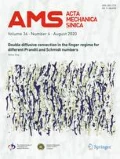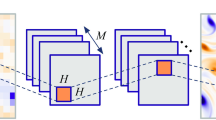Abstract
Coherent structures of a turbulent boundary layer were investigated by hydrogen bubble method. A kind of fast changing structure was observed. That is a spot in which all the hydrogen bubbles vanish much faster than in other regions. This investigation verified that dark-spot is formed by a strong sweep from outer layer. Inside a dark-spot the local instantaneous flow speed might be four times of its neighboring high-speed streaks. Comparing with the low/high speed streaks, both dark-spot and the vortical structures around it are changing very fast. Around dark-spot intensive shear layers are formed and indications of the generation of small-scale structures could be observed.
Similar content being viewed by others
References
Cantwell B. Future direction in turbulence research and the role of organized motion. In Lumley JL ed. Whither Turbulence? Turbulence at Crossroads. Proc of a Workshop on Turbulence, Cornell University, March 22–24, 1989. New York: Springer-Verlag. 1990. 97–131
Kline SJ, Reynolds WC, Schraub FA, Runstadler PW. Structures of turbulent boundary layer.J Fluid Mech, 1967, 37: 741–773
Kim HT, Kline SJ, Reynolds WC. The production of turbulence near a smooth wall in a turbulent boundary layer.J Fluid Mech, 1971, 50: 133–160
Smith CR, Walker DA. Sustain mechanism of turbulent boundary layer: The role of vortex development and interactions. In Panton RL ed. Advances in Fluid Mechanics. Vol. 15. Boston, USA: Computational Mechanics Publications, 1997. 13–47
Praturi AK, Brodkey RS. A stereoscopic visual study of the coherent structures in turbulent shear flow.J Fluid Mech, 1978, 89: 251–272
Talmon AM, Kunen JMG, Oom G. Simultaneous flow visualization and Reynolds-stress measurement in a turbulent boundary layer.J Fluid Mech, 1986, 163: 459–478
Lian QX. A visual study of the coherent structure of turbulent boundary layer in flow with adverse pressure gradient.J Fluid Mech, 1990, 215: 101–124
Lian QX, Su TC. The applications of the hydrogen bubble method in the investigations of complex flows.Atlas of Visualization, 1996, 2: 105–115
Lian QX, Su TC. Large vortex in front stagnation region of a square plate induced by a fine interference wire.Science in China (Series A), 1994, 37: 469–477
Xu C, Zhang Z, den Tooder JMJ, Niewstadt FTM. Origin of high kurtosis in the viscous sublayer.Phys Fluids, 1996, 8(7): 1938–1944
Brooke JW, Hanratty TJ. Origin of turbulence producing-eddies in a turbulent channel flow.Phys Fluids A, 1993, 5(4): 1011–1022
Author information
Authors and Affiliations
Additional information
The project supported by the National Natural Science Foundation of China (No. 19672004) and the National Climbing Project
Rights and permissions
About this article
Cite this article
Qixiang, L. A kind of fast changing coherent structure in a turbulent boundary layer. Acta Mech Sinica 15, 193–200 (1999). https://doi.org/10.1007/BF02486147
Received:
Issue Date:
DOI: https://doi.org/10.1007/BF02486147




